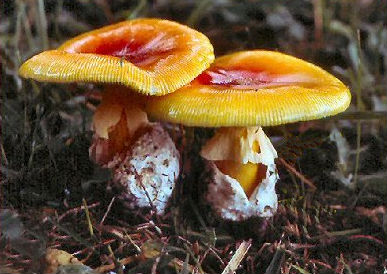
These fungi are indescribably delicious when tossed with pasta along with olive oil and possibly a touch of garlic.
This culinary prize, Amanita Caesarea appears in Autumn although the season can vary depending on location. At first glance its distinguishing characteristics are: A somewhat shiny reddish cap with radial lines around the margins; yellowish gills and a ring around the yellowish stalk with scattered white tissues; and a saclike cup at the base of the stalk, typical of many amanitas. This mushroom is highly prized, and is a common sight in the markets of Italy, southern France, and Spain. However, many mycologists warn inexperienced gatherers against seeking it out as it can be easily confused with other deadly members of the Amanita genus, for example Amanita Muscaria or Amanita Phialloides.
The well-known, hallucinogenic Fly Agaric has no radially lined margins around the cap and has whitish gills. A close inspection should easily allow identification of either of these similar mushrooms that are members of the dangerous genus Amanita.
The genus Amanita is better known for its poisonous members the death angels (Amanita virosa, A. bisporigera, A. verna), the destroying angel or death cap (A. phalloides) and the hallucinogenic and toxic fly agaric (A. muscaria).
No foraged mushrooms should be eaten without the advice of an expert!

